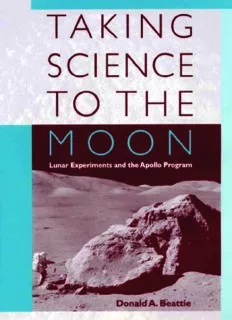
Taking science to the moon : lunar experiments and the Apollo Program PDF
Preview Taking science to the moon : lunar experiments and the Apollo Program
Taking Science to the Moon New Series in NASA History Roger D. Launius, Series Editor Before Lift-o√: The Making of a Space Shuttle Crew by Henry S. F. Cooper, Jr. The Space Station Decision: Incremental Politics and Technological Choice by Howard E. McCurdy Exploring the Sun: Solar Science since Galileo by Karl Hufbauer Inside NASA: High Technology and Organizational Change in the U.S. Space Program by Howard E. McCurdy Powering Apollo: James E. Webb of NASA by W. Henry Lambright NASA and the Space Industry by Joan Lisa Bromberg Taking Science to the Moon: Lunar Experiments and the Apollo Program by Donald A. Beattie Taking Science to the Moon Lunar Experiments and the Apollo Program Donald A. Beattie The Johns Hopkins University Press Baltimore and London ∫ 2001 The Johns Hopkins University Press All rights reserved. Published 2001 Printed in the United States of America on acid-free paper 9 8 7 6 5 4 3 2 1 The Johns Hopkins University Press 2715 North Charles Street Baltimore, Maryland 21218-4363 www.press.jhu.edu Library of Congress Cataloging-in-Publication Data Beattie, Donald A. Taking science to the moon: lunar experiments and the Apollo Program / Donald A. Beattie. p. cm. — (New series in NASA history) Includes bibliographical references and index. ISBN 0-8018-6599-9 1. Project Apollo (U.S.) 2. Apollo Lunar Surface Experiments Package. 3. Moon—Exploration—Instruments. I. Title. II. Series. TL789.8.U6 A5186 2001 629.45%4%0973—dc21 00-010272 A catalog record for this book is available from the British Library. Frontispiece: Night launch of the final Apollo mission (Apollo 17) as viewed from Kennedy Space Center, December 7, 1972. (NASA S72-55070) Contents Preface vii Acknowledgments ix List of Abbreviations and Acronyms xi Introduction xiii 1 From the Jungle to Washington ∞ 2 Early Theories and Questions about the Moon ∞≤ 3 What Do We Do after Apollo? ≤∫ 4 The United States Geological Survey Joins Our Team ∑∫ 5 Science Payloads for Apollo: The Struggle Begins π∫ 6 Developing the Geological Equipment, Related Experiments, and Sampling Protocols ∞≠π 7 The Apollo Lunar Surface Experiments Package and Associated Experiments ∞≤∑ 8 Walk, Fly, or Drive? ∞∂∏ 9 Astronaut Training and Mission Simulation ∞∑Ω 10 Studying the Moon from Orbit ∞∫Ω Contents 11 On to the Moon: Science Becomes the Focus ∞Ω∂ 12 The J Missions: We Almost Achieve Our Early Dreams ≤≤π 13 The Legacy of Apollo ≤∑∞ Notes ≤π∑ Selected Bibliography ≤∫Ω Index ≤Ω∞ vi Preface The technical achievements that permitted the National Aeronautics and Space Administration (NASA), other government agencies, and their contractors to fulfill President John F. Kennedy’s promise of ‘‘landing a man on the moon and returning him safely’’ have often been described. Most previous authors have included anecdotes that enhance our appreciation of how Project Apollo was successfully accomplished, although many are retold at second or third hand. Several movies such as The Right Stu√ and Apollo 13 showed both true and fictional accounts of the spirit and engineering skills that characterized the entire project, focusing primarily on the major or well-known participants. A story that has not been completely told, however, is how a small band of somewhat anonymous NASA sta√ers, allied with scientists inside and outside government, struggled to persuade the management of NASA to look beyond the initial Apollo landing and reap a scientific harvest from this historic under- taking. Here is that story as seen through the eyes of a participant based at NASA headquarters—a pack rat who kept many of the internal memos, reports, photos, and notes that document that ten-year struggle. It highlights the contri- butions of many of those who worked with me during the Apollo program. Some of them have received little public recognition for their e√orts. I hope that this insider background will give readers a better understanding of the behind-the-scenes maneuvering that led to many of Project Apollo’s scientific achievements, which have enriched our understanding not only of the Moon but, more important, of the small planet we call Earth. vii Acknowledgments Many people and organizations helped and encouraged me while I was writing this book, and they deserve credit. Although I had saved many boxes of material I collected during my Apollo days at NASA in anticipation of one day writing this story, I soon found this source material was insu≈cient. Calling old col- leagues to ask if they had kept records was not very fruitful at first, but even- tually I was successful. The first person who agreed to share his records covering part of this period was Robert Fudali, who was on the Bellcomm sta√ during Apollo’s early days. His material not only contributed to the accuracy of this story but served as a valuable reminder of some of the events that occurred during the formative years of Apollo science. I have quoted liberally from a few of Bob’s colorful internal memos. Gordon Swann, a friend, former colleague, and principal investigator who took part in the struggle to develop science payloads for Apollo, especially those aspects related to the astronauts’ geological investigations, reviewed early drafts and provided many important comments and suggestions as well as a few of his famous anecdotes—some printable, some not. Gordon should be encouraged to one day write his account of Apollo. Paul Lowman, who figures prominently in this story, was an invaluable source of material and a resource for clarifying many events. Paul is renowned among his NASA colleagues as a pack rat of the first degree: his o≈ce is so filled with reports and trivia that when you first enter it is hard to find his desk. However, his propensity for maintaining his archives has benefited many who have written about NASA’s early days. He also reviewed the manuscript and o√ered many useful comments. ix
